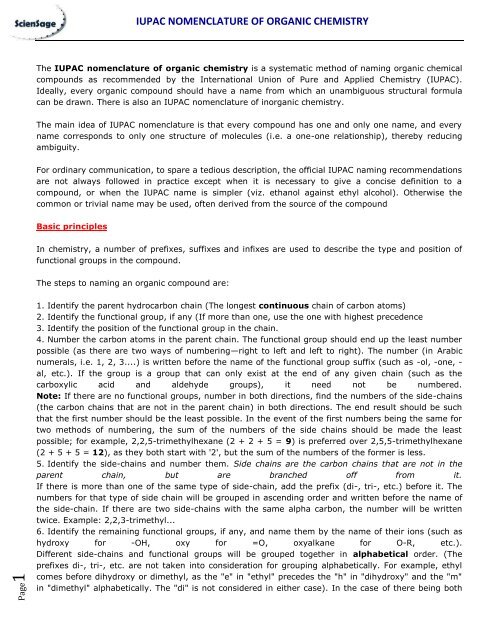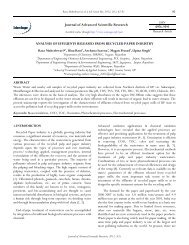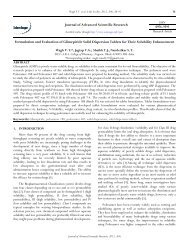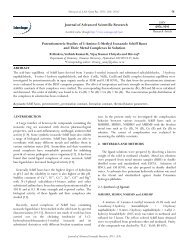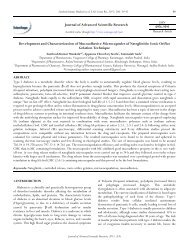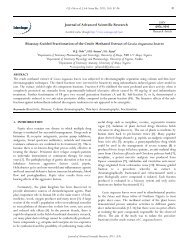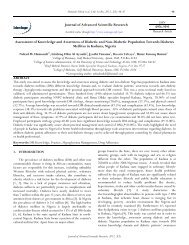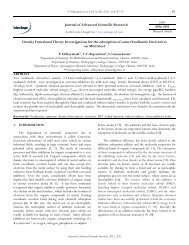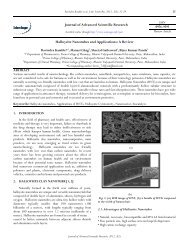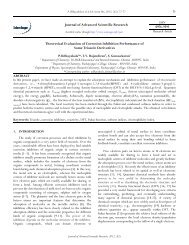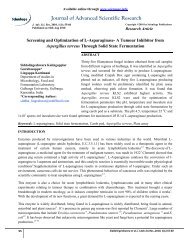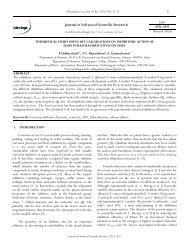iupac nomenclature of organic chemistry - Sciensage.info
iupac nomenclature of organic chemistry - Sciensage.info
iupac nomenclature of organic chemistry - Sciensage.info
You also want an ePaper? Increase the reach of your titles
YUMPU automatically turns print PDFs into web optimized ePapers that Google loves.
Page1<br />
IUPAC NOMENCLATURE OF ORGANIC CHEMISTRY<br />
The IUPAC <strong>nomenclature</strong> <strong>of</strong> <strong>organic</strong> <strong>chemistry</strong> is a systematic method <strong>of</strong> naming <strong>organic</strong> chemical<br />
compounds as recommended by the International Union <strong>of</strong> Pure and Applied Chemistry (IUPAC).<br />
Ideally, every <strong>organic</strong> compound should have a name from which an unambiguous structural formula<br />
can be drawn. There is also an IUPAC <strong>nomenclature</strong> <strong>of</strong> in<strong>organic</strong> <strong>chemistry</strong>.<br />
The main idea <strong>of</strong> IUPAC <strong>nomenclature</strong> is that every compound has one and only one name, and every<br />
name corresponds to only one structure <strong>of</strong> molecules (i.e. a one-one relationship), thereby reducing<br />
ambiguity.<br />
For ordinary communication, to spare a tedious description, the <strong>of</strong>ficial IUPAC naming recommendations<br />
are not always followed in practice except when it is necessary to give a concise definition to a<br />
compound, or when the IUPAC name is simpler (viz. ethanol against ethyl alcohol). Otherwise the<br />
common or trivial name may be used, <strong>of</strong>ten derived from the source <strong>of</strong> the compound<br />
Basic principles<br />
In <strong>chemistry</strong>, a number <strong>of</strong> prefixes, suffixes and infixes are used to describe the type and position <strong>of</strong><br />
functional groups in the compound.<br />
The steps to naming an <strong>organic</strong> compound are:<br />
1. Identify the parent hydrocarbon chain (The longest continuous chain <strong>of</strong> carbon atoms)<br />
2. Identify the functional group, if any (If more than one, use the one with highest precedence<br />
3. Identify the position <strong>of</strong> the functional group in the chain.<br />
4. Number the carbon atoms in the parent chain. The functional group should end up the least number<br />
possible (as there are two ways <strong>of</strong> numbering—right to left and left to right). The number (in Arabic<br />
numerals, i.e. 1, 2, 3....) is written before the name <strong>of</strong> the functional group suffix (such as -ol, -one, -<br />
al, etc.). If the group is a group that can only exist at the end <strong>of</strong> any given chain (such as the<br />
carboxylic acid and aldehyde groups), it need not be numbered.<br />
Note: If there are no functional groups, number in both directions, find the numbers <strong>of</strong> the side-chains<br />
(the carbon chains that are not in the parent chain) in both directions. The end result should be such<br />
that the first number should be the least possible. In the event <strong>of</strong> the first numbers being the same for<br />
two methods <strong>of</strong> numbering, the sum <strong>of</strong> the numbers <strong>of</strong> the side chains should be made the least<br />
possible; for example, 2,2,5-trimethylhexane (2 + 2 + 5 = 9) is preferred over 2,5,5-trimethylhexane<br />
(2 + 5 + 5 = 12), as they both start with '2', but the sum <strong>of</strong> the numbers <strong>of</strong> the former is less.<br />
5. Identify the side-chains and number them. Side chains are the carbon chains that are not in the<br />
parent chain, but are branched <strong>of</strong>f from it.<br />
If there is more than one <strong>of</strong> the same type <strong>of</strong> side-chain, add the prefix (di-, tri-, etc.) before it. The<br />
numbers for that type <strong>of</strong> side chain will be grouped in ascending order and written before the name <strong>of</strong><br />
the side-chain. If there are two side-chains with the same alpha carbon, the number will be written<br />
twice. Example: 2,2,3-trimethyl...<br />
6. Identify the remaining functional groups, if any, and name them by the name <strong>of</strong> their ions (such as<br />
hydroxy for -OH, oxy for =O, oxyalkane for O-R, etc.).<br />
Different side-chains and functional groups will be grouped together in alphabetical order. (The<br />
prefixes di-, tri-, etc. are not taken into consideration for grouping alphabetically. For example, ethyl<br />
comes before dihydroxy or dimethyl, as the "e" in "ethyl" precedes the "h" in "dihydroxy" and the "m"<br />
in "dimethyl" alphabetically. The "di" is not considered in either case). In the case <strong>of</strong> there being both
Page2<br />
side chains and secondary functional groups, they should be written mixed together in one group rather<br />
than in two separate groups.<br />
7. Identify double/triple bonds. Number them with the number <strong>of</strong> the carbon atom at the head <strong>of</strong> the<br />
bond (i.e. the carbon atom with the lesser number that it is attached to). For example a double bond<br />
between carbon atoms 3 and 4 is numbered as 3-ene. Multiple bonds <strong>of</strong> one type (double/triple) are<br />
named with a prefix (di-, tri-, etc.). If both types <strong>of</strong> bonds exist, then use "ene" before "yne" e.g. "6 13<br />
diene 19 yne". If all bonds are single, use "ane" without any numbers or prefixes.<br />
8. Arrange everything like this: Group <strong>of</strong> side chains and secondary functional groups with<br />
numbers made in step 3 + prefix <strong>of</strong> parent hydrocarbon chain (eth, meth) + double/triple<br />
bonds with numbers (or "ane") + primary functional group suffix with numbers.<br />
Wherever it says "with numbers", it is understood that between the word and the numbers,<br />
you use the prefix(di-, tri-)<br />
1. Add punctuation:<br />
2. Put commas between numbers (2 5 5 becomes 2,5,5)<br />
3. Put a hyphen between a number and a letter (2 5 5 trimethylhexane becomes 2,5,5-<br />
trimethylhexane)<br />
4. Successive words are merged into one word (trimethyl hexane becomes trimethylhexane)<br />
NOTE: IUPAC uses one-word names throughout. This is why all parts are connected.<br />
The finalized name should look like this:<br />
#,#-di-#--#--#,#,#-tri-#,#-di-#-<br />
-#-<br />
Note: # is used for a number. The group secondary functional groups and side chains may not look the<br />
same as shown here, as the side chains and secondary functional groups are arranged alphabetically.<br />
The di- and tri- have been used just to show their usage. (di- after #,#, tri- after #,#,# , etc.)<br />
Example:<br />
Here is a sample molecule with the parent carbons numbered:<br />
For simplicity, here is an image <strong>of</strong> the same molecule, where the hydrogens in the parent chain are<br />
removed and the carbons are shown by their numbers:
Page3<br />
Now, we go by the steps:<br />
1. The parent hydrocarbon chain has 23 carbons. It is called tricos-.<br />
2. The functional groups with the highest precedence are the two ketone groups.<br />
3. The groups are on carbon atoms 3 & 9. As there are two, we write 3,9-dione.<br />
4. The numbering <strong>of</strong> the molecule is based on the ketone groups. when numbering from left to<br />
right, the ketone groups get numbered 3 and 9.when numbering from right to left, the ketone<br />
groups get numbered 15 and 21. 3 is less than 15, therefore, the numbering is done left to<br />
right, and the ketones are numbered 3 & 9. The lesser number is always used, not the sum <strong>of</strong><br />
the constituents numbers.<br />
5. The side chains are: an ethyl- at carbon 4, an ethyl- at carbon 8, and a butyl- at carbon 12.<br />
NOTE: The -O-CH 3 at carbon atom 15 is not a side chain, but it is a methoxy functional group<br />
o There are two ethyl- groups, so they are combined to create, 4,8-diethyl.<br />
o The side chains shall be grouped like this: 12-butyl-4,8-diethyl. (But this is not the final<br />
grouping, as functional groups may be added in between.)<br />
The secondary functional groups are: a hydroxy- at carbon 5, a chloro- at carbon 11, a methoxy- at<br />
carbon 15, and a bromo- at carbon 18. Grouped with the side chains, we get 18-bromo-12-butyl-11-<br />
chloro-4,8-diethyl-5-hydroxy-15-methoxy<br />
There are two double bonds: one between carbons 6 & 7, and one between carbons 13 & 14. They will<br />
be called 6,13-diene. There is one triple bond between carbon atoms 19 & 20. It will be called 19-yne<br />
The arrangement (with punctuation) is: 18-bromo-12-butyl-11-chloro-4,8-diethyl-5-hydroxy-15-<br />
methoxytricos-6,13-dien-19-yne-3,9-dione<br />
The final name is 18-bromo-12-butyl-11-chloro-4,8-diethyl-5-hydroxy-15-methoxytricos-6,13-<br />
dien-19-yne-3,9-dione.<br />
Alkanes<br />
Straight-chain alkanes take the suffix "-ane" and are prefixed depending on the number <strong>of</strong> carbon<br />
atoms in the chain, following standard rules. The first few are:<br />
Number<br />
carbons<br />
<strong>of</strong><br />
1 2 3 4 5 6 7 8 9 10 11 12 13<br />
Prefix Meth Eth Prop But Pent Hex Hept Oct Non Dec Undec Dodec Tridec<br />
For example, the simplest alkane is CH 4 methane, and the nine-carbon alkane CH 3 (CH 2 ) 7 CH 3 is named<br />
nonane. The names <strong>of</strong> the first four alkanes were derived from methanol, ether, propionic acid and<br />
butyric acid, respectively. The rest are named with a Greek numeric prefix, with the exceptions <strong>of</strong><br />
nonane which has a Latin prefix, and undecane and tridecane which have mixed-language prefixes.<br />
Cyclic alkanes are simply prefixed with "cyclo-", for example C 4 H 8 is cyclobutane and C 6 H 12 is<br />
cyclohexane.
Page4<br />
Branched alkanes are named as a straight-chain alkane with attached alkyl groups. They are prefixed<br />
with a number indicating the carbon the group is attached to, counting from the end <strong>of</strong> the alkane<br />
chain. For example, (CH 3 ) 2 CHCH 3 , commonly known as isobutane, is treated as a propane chain with a<br />
methyl group bonded to the middle (2) carbon, and given the systematic name 2-methylpropane.<br />
However, although the name 2-methylpropane COULD be used, it is easier and more logical to call it<br />
simply methylpropane - the methyl group could not possible occur on any <strong>of</strong> the other cabon atoms<br />
(that would lengthen the chain and result in butane, not propane) and therefore the use <strong>of</strong> the number<br />
"2" is not necessary.<br />
If there is ambiguity in the position <strong>of</strong> the substituent,<br />
depending on which end <strong>of</strong> the alkane chain is counted as "1",<br />
then numbering is chosen so that the smallest number is used.<br />
For example, (CH 3 ) 2 CHCH 2 CH 3 (isopentane) is named 2-<br />
methylbutane, not 3-methylbutane.<br />
If there are multiple side-branches <strong>of</strong> the same size alkyl group, their positions are separated by<br />
commas and the group prefixed with di-, tri-, tetra-, etc., depending on the number <strong>of</strong> branches (e.g.<br />
C(CH 3 ) 4 2,2-dimethylpropane). If there are different groups, they are added in alphabetical order,<br />
separated by commas or hyphens: 3-ethyl-4-methylhexane. The longest possible main alkane chain is<br />
used; therefore 3-ethyl-4-methylhexane instead <strong>of</strong> 2,3-diethylpentane, even though these describe<br />
equivalent structures. The di-, tri- etc. prefixes are ignored for the purpose <strong>of</strong> alphabetical ordering <strong>of</strong><br />
side chains (e.g. 3-ethyl-2,4-dimethylpentane, not 2,4-dimethyl-3-ethylpentane).<br />
Alkenes and Alkynes<br />
Alkenes are named for their parent alkane chain with the<br />
suffix "-ene" and an infixed number indicating the position <strong>of</strong><br />
the double-bonded carbon in the chain: CH 2 =CHCH 2 CH 3 is but-<br />
1-ene. Multiple double bonds take the form -diene, -triene,<br />
etc., with the size prefix <strong>of</strong> the chain taking an extra "a":<br />
CH 2 =CHCH=CH 2 is buta-1,3-diene. Simple cis and trans<br />
isomers are indicated with a prefixed cis- or trans-: cis-but-2-<br />
ene, trans-but-2-ene.
Page5<br />
More complex geometric isomerisations are described using the Cahn Ingold Prelog priority rules.<br />
Alkynes are named using the same system, with the suffix "-yne" indicating a triple bond: ethyne<br />
(acetylene),propyne(methylacetylene).<br />
Functional groups<br />
Alk is the prefix <strong>of</strong> the group (Meth, Eth, Prop, etc.)<br />
Family<br />
Alkyl<br />
groups<br />
Halogens<br />
Structure<br />
IUPAC<br />
<strong>nomenclature</strong><br />
IUPAC <strong>nomenclature</strong> for cyclic<br />
parent<br />
chains Common<br />
(if different from straight <strong>nomenclature</strong><br />
chains)<br />
R— Alkyl - Alkyl<br />
R—x<br />
(halogen)<br />
Halo'alkane - Alkyl halide<br />
Alcohols R—OH Alkanol - Alkyl alcohol<br />
Amines R—NH 2 Alkanamine - Alkyl amine<br />
Carboxylic<br />
acids<br />
(Alk + 1)anoic<br />
acid<br />
Cycloalkanecarboxylic acid -<br />
Aldehydes Alkanal Cycloalkanecarboxaldehyde -<br />
Ketones Alkanone -<br />
Alk (1) yl<br />
ketone<br />
Alk (2) yl<br />
Thiols R—SH Alkanethiol - -<br />
Amides<br />
(Alk +<br />
1)anamide<br />
Cycloalkanecarboxamide -<br />
Ethers R 1 —O—R 2 alkoxyalkane -<br />
Alk (1) yl<br />
ether<br />
Alk (2) yl<br />
Esters<br />
Alk (1) yl<br />
Alk (2) aneoate<br />
Alk (1) yl<br />
Cycloalk (2) anecarboxylate<br />
Alk (1) yl (Alk +<br />
1) (2) anoate
Page6<br />
Alcohols<br />
Alcohols (R-OH) take the suffix "-ol" with an infix numerical bonding position: CH 3 CH 2 CH 2 OH is propan-<br />
1-ol. The suffixes -diol, -triol, -tetraol, etc., are used for multiple -OH groups: Ethylene glycol<br />
CH 2 OHCH 2 OH is ethane-1,2-diol.<br />
If higher precedence functional groups are present (see order <strong>of</strong><br />
precedence, below), the prefix "hydroxy" is used with the bonding<br />
position: CH 3 CHOHCOOH is 2-hydroxypropanoic acid.<br />
Halogens (Alkyl Halides)<br />
Halogen functional groups are prefixed with the bonding position and take the form fluoro-, chloro-,<br />
bromo-, iodo-, etc., depending on the halogen. Multiple groups are dichloro-, trichloro-, etc, and<br />
dissimilar groups are ordered alphabetically as before. For example, CHCl 3 (chlor<strong>of</strong>orm) is<br />
trichloromethane. The anesthetic Halothane (CF 3 CHBrCl) is 1-bromo-1-chloro-2,2,2-trifluoroethane.<br />
Ketones In general ketones (R-CO-R) take the suffix "-<br />
one" (pronounced own, not won) with an infix<br />
position number: CH 3 CH 2 CH 2 COCH 3 is pentan-2-<br />
one. If a higher precedence suffix is in use,<br />
the prefix "oxo-" is used:<br />
CH 3 CH 2 CH 2 COCH 2 CHO is 3-oxohexanal.
Page7<br />
Aldehydes<br />
Aldehydes (R-CHO) take the suffix "-al". If other functional groups are present, the chain is numbered<br />
such that the aldehyde carbon is in the "1" position, unless functional groups <strong>of</strong> higher precedence are<br />
present.If a prefix form is required, "oxo-" is used (as for ketones), with the position number indicating<br />
the end <strong>of</strong> a chain: CHOCH 2 COOH is 3-oxopropanoic acid. If the carbon in the carbonyl group cannot be<br />
included in the attached chain (for instance in the case <strong>of</strong> cyclic aldehydes), the prefix "formyl-" or the<br />
suffix "-carbaldehyde" is used: C 6 H 11 CHO is cyclohexanecarbaldehyde. If a aldehyde is attached to a<br />
benzene and is the main functional group, the suffix becomes benzaldehyde<br />
Carboxylic acids<br />
In general carboxylic acids are named with the suffix -oic acid<br />
(etymologically a back-formation from benzoic acid). As for aldehydes, they<br />
take the "1" position on the parent chain, but do not have their position<br />
number indicated. For example, CH 3 CH 2 CH 2 CH 2 COOH (valeric acid) is<br />
named pentanoic acid.<br />
For common carboxylic acids some traditional names such as acetic acid are in such<br />
widespread use they are considered retained IUPAC names, although "systematic" names such as<br />
ethanoic acid are also acceptable. For carboxylic acids attached to a benzene ring such as Ph-COOH,<br />
these are named as benzoic acid or its derivatives.<br />
If there are multiple carboxyl groups on the same parent chain, the suffix "-carboxylic acid" can be<br />
used (as -dicarboxylic acid, -tricarboxylic acid, etc.). In these cases, the carbon in the carboxyl group<br />
does not count as being part <strong>of</strong> the main alkane chain. The same is true for the prefix form, "carboxyl-<br />
". Citric acid is one example; it is named 2-hydroxypropane- 1,2,3-tricarboxylic acid, rather than 2-<br />
carboxy,2-hydroxypentanedioicacid.<br />
Ethers<br />
Ethers (R-O-R) consist <strong>of</strong> an oxygen atom between the two attached carbon chains. The shorter <strong>of</strong> the<br />
two chains becomes the first part <strong>of</strong> the name with the -ane suffix changed to -oxy, and the longer<br />
alkane chain become the suffix <strong>of</strong> the name <strong>of</strong> the ether. Thus CH 3 OCH 3 is methoxymethane, and<br />
CH 3 OCH 2 CH 3 is methoxyethane (not ethoxymethane). If the oxygen is not attached to the end <strong>of</strong> the<br />
main alkane chain, then the whole shorter alkyl-plus-ether group is treated as a side-chain and prefixed<br />
with its bonding position on the main chain. Thus CH 3 OCH(CH 3 ) 2 is 2-methoxypropane.
Page8<br />
Esters<br />
Esters (R-CO-O-R') are named as alkyl derivatives <strong>of</strong> carboxylic acids. The alkyl (R') group is named<br />
first. The R-CO-O part is then named as a separate word based on the carboxylic acid name, with the<br />
ending changed from -oic acid to -oate. For example, CH 3 CH 2 CH 2 CH 2 COOCH 3 is methyl pentanoate, and<br />
(CH 3 ) 2 CHCH 2 CH 2 COOCH 2 CH 3 is ethyl 4-methylpentanoate. For esters such as ethyl acetate<br />
(CH 3 COOCH 2 CH 3 ), ethyl formate (HCOOCH 2 CH 3 ) or dimethyl phthalate that are based on common<br />
acids, IUPAC recommends use <strong>of</strong> these established names, called retained names. The -oate changes to<br />
-ate.<br />
If the alkyl group is not attached at the end <strong>of</strong> the chain, the<br />
bond position to the ester group is infixed before "-yl":<br />
CH 3 CH 2 CH(CH 3 )OOCCH 2 CH 3 may be called but-2-yl<br />
propanoate or but-2-yl propionate.<br />
Amines and Amides<br />
Amines (R-NH 2 ) are named for the attached<br />
alkane chain with the suffix "-amine" (e.g.<br />
CH 3 NH 2 methanamine). If necessary, the<br />
bonding position is infixed: CH 3 CH 2 CH 2 NH 2<br />
propan-1-amine, CH 3 CHNH 2 CH 3 propan-2-<br />
amine. The prefix form is "amino-".<br />
For secondary amines (<strong>of</strong> the form R-NH-R), the longest carbon chain attached to the nitrogen atom<br />
becomes the primary name <strong>of</strong> the amine; the other chain is prefixed as an alkyl group with location<br />
prefix given as an italic N: CH 3 NHCH 2 CH 3 is N-methylethanamine. Tertiary amines (R-NR-R) are treated<br />
similarly: CH 3 CH 2 N(CH 3 )CH 2 CH 2 CH 3 is N-ethyl-N-methylpropanamine. Again, the substituent groups are<br />
ordered alphabetically.
Page9<br />
Amides (R-CO-NH 2 ) take the suffix "-amide". There is no<br />
prefix form, and no location number is required since they<br />
always terminate a carbon chain, e.g. CH 3 CONH 2<br />
(acetamide) is named ethanamide. Secondary and tertiary<br />
amides are treated similarly to the case <strong>of</strong> amines: alkane<br />
chains bonded to the nitrogen atom are treated as<br />
substituents with the location prefix N: HCON(CH 3 ) 2 is N,Ndimethylmethanamide.<br />
Cyclic compounds<br />
Cycloalkanes and aromatic compounds can be<br />
treated as the main parent chain <strong>of</strong> the<br />
compound, in which case the position <strong>of</strong><br />
substituents are numbered around the ring<br />
structure. For example, the three isomers <strong>of</strong><br />
xylene CH 3 C 6 H 4 CH 3 , commonly the ortho-, meta-,<br />
and para- forms, are 1,2-dimethylbenzene, 1,3-<br />
dimethylbenzene, and 1,4-dimethylbenzene.<br />
The cyclic structures can also be treated as functional groups themselves, in which case they take the<br />
prefix "cycloalkyl-" (e.g. "cyclohexyl-") or for benzene, "phenyl-".<br />
The IUPAC <strong>nomenclature</strong> scheme becomes rapidly more elaborate for more complex cyclic structures,<br />
with notation for compounds containing conjoined rings, and many common names such as phenol,<br />
furan, indole, etc. being accepted as base names for compounds derived from them.<br />
Order <strong>of</strong> precedence <strong>of</strong> groups<br />
When compounds contain more than one functional group, the order <strong>of</strong> precedence determines which<br />
groups are named with prefix or suffix forms. The highest precedence group takes the suffix, with all<br />
others taking the prefix form. However, double and triple bonds only take suffix form (-en and -yn) and<br />
are used with other suffixes.<br />
Prefixed substituents are ordered alphabetically (excluding any modifiers such as di-, tri-, etc.), e.g.<br />
chlor<strong>of</strong>luoromethane, not fluorochloromethane. If there are multiple functional groups <strong>of</strong> the same type,<br />
either prefixed or suffixed, the position numbers are ordered numerically (thus ethane-1,2-diol, not<br />
ethane-2,1-diol.) The N position indicator for amines and amides comes before "1", e.g.<br />
CH 3 CH(CH 3 )CH 2 NH(CH 3 ) is N,2-dimethylpropanamine.<br />
Priority Functional group Formula Prefix Suffix<br />
1<br />
2<br />
Cations<br />
e.g. Ammonium –NH 4<br />
+<br />
Carboxylic<br />
Thiocarboxylic<br />
Selenocarboxylic<br />
Sulfonic<br />
Sulfinic<br />
Sulfenic acids<br />
acids<br />
acids<br />
acids<br />
acids<br />
acids<br />
–COOH<br />
–COSH<br />
–COSeH<br />
–SO 3 H<br />
–SO 2 H<br />
–SOH<br />
-onioammonio-<br />
-onium<br />
-ammonium<br />
carboxy- -oic acid*<br />
thiocarboxy- -thioic acid*<br />
selenocarboxy- -selenoic acid*<br />
sulfo-<br />
-sulfonic acid<br />
sulfino- -sulfinic acid<br />
sulfeno- -sulfenic acid
Page10<br />
3<br />
Carboxylic acid derivatives<br />
Esters<br />
Acyl<br />
Amides<br />
Imides<br />
Amidines<br />
halides<br />
–COOR<br />
–COX<br />
–CONH 2<br />
–CON=C<<br />
–C(=NH)NH 2<br />
R-oxycarbonylhalidealcanoylcarbamoyl-<br />
-imidoamidino-<br />
-R-oate<br />
-oyl halide*<br />
-amide*<br />
-imide*<br />
-amidine*<br />
4<br />
Nitriles<br />
Isocyanides<br />
–CN<br />
–NC<br />
cyanoisocyano-<br />
-nitrile*<br />
isocyanide<br />
5<br />
Aldehydes<br />
Thioaldehydes<br />
–CHO<br />
–CHS<br />
formylthi<strong>of</strong>ormyl-<br />
-al*<br />
-thial*<br />
6<br />
Ketones<br />
Thioketones<br />
>CO<br />
>CS<br />
oxothiono-<br />
-one<br />
-thione<br />
7<br />
Alcohols<br />
Thiols<br />
Selenols<br />
Tellurols<br />
–OH<br />
–SH<br />
–SeH<br />
–TeH<br />
hydroxysulfanylselanyltellanyl-<br />
-ol<br />
-thiol<br />
-selenol<br />
-tellurol<br />
8 Hydroperoxides –OOH hydroperoxy- -hydroperoxide<br />
9<br />
Amines<br />
Imines<br />
Hydrazines<br />
–NH 2<br />
=NH<br />
–NHNH 2<br />
aminoiminohydrazino-<br />
-amine<br />
-imine<br />
-hydrazine<br />
10<br />
Ethers<br />
Thioethers<br />
Selenoethers<br />
–O–<br />
–S–<br />
–Se–<br />
-oxy-<br />
-thio-<br />
-seleno-<br />
11<br />
Peroxides<br />
Disulfides<br />
–OO–<br />
–SS–<br />
-peroxy-<br />
-disulfanyl-<br />
Common <strong>nomenclature</strong> - trivial names<br />
Common <strong>nomenclature</strong> is an older system <strong>of</strong> naming <strong>organic</strong> compounds. Instead <strong>of</strong> using the prefixes<br />
for the carbon skeleton above, another system is used. The pattern can be seen below.<br />
Number<br />
carbons<br />
<strong>of</strong><br />
Prefix as in new<br />
system<br />
Common name for<br />
alcohol<br />
Common name for<br />
aldehyde<br />
Common<br />
for acid<br />
name<br />
1 Meth<br />
Methyl alcohol (wood<br />
alcohol)<br />
Formaldehyde<br />
Formic acid<br />
2 Eth<br />
Ethyl alcohol (grain<br />
alcohol)<br />
Acetaldehyde<br />
Acetic acid<br />
3 Prop Propyl alcohol Propionaldehyde Propionic acid<br />
4 But Butyl alcohol Butyraldehyde Butyric acid<br />
5 Pent Amyl alcohol Valeraldehyde Valeric acid<br />
6 Hex - Caproaldehyde Caproic acid<br />
7 Hept Enanthyl alcohol Enanthaldehyde Enanthoic acid<br />
8 Oct Capryl alcohol Caprylaldehyde Caprylic acid<br />
9 Non - Pelargonaldehyde Pelargonic acid
Page11<br />
10 Dec Capric alcohol Capraldehyde Capric acid<br />
11 Undec<br />
12 Dodec Lauryl alcohol Lauraldehyde Lauric acid<br />
14 Tetradec - Myristaldehyde Myristic acid<br />
16 Hexadec Cetyl alcohol Palmitaldehyde Palmitic acid<br />
17 Heptadec - - Margaric acid<br />
18 Octadec Stearyl alcohol Stearaldehyde Stearic acid<br />
20 Icos Arachidyl alcohol - Arachidic acid<br />
22 Docos Behenyl alcohol - Behenic acid<br />
24 Tetracos Lignoceryl alcohol - Lignoceric acid<br />
26 Hexacos Cerotinyl alcohol - Cerotinic acid<br />
28 Octacos Mountainyl alcohol - Mountainic acid<br />
30 Triacont Melissyl alcohol - Melissic acid<br />
Ketones<br />
Common names for ketones can be derived by naming the two alkyl or aryl groups bonded to the<br />
carbonyl group as separate words followed by the word ketone.<br />
<br />
<br />
<br />
<br />
<br />
Acetone<br />
Acetophenone<br />
Benzophenone<br />
Ethyl isopropyl ketone<br />
Diethyl ketone<br />
The first three <strong>of</strong> the names shown above are still considered to be acceptable IUPAC names.<br />
Aldehydes<br />
The common name for an aldehyde is derived from the common name <strong>of</strong> the corresponding carboxylic<br />
acid by dropping the word acid and changing the suffix from -ic or -oic to -aldehyde.<br />
<br />
<br />
Formaldehyde<br />
Acetaldehyde<br />
Hydron<br />
Hydron is a generic term for hydrogen cation; protons, deuterons and tritons are all hydrons.<br />
Parent hydride cations<br />
Simple cations formed by adding a hydron to a hydride <strong>of</strong> a halogen, chalcogen or nitrogen-family<br />
element are named by adding the suffix "-onium" to the element's root: H 4 N + is ammonium, H 3 O + is<br />
oxonium, and H 2 F + is fluoronium. Ammonium was adopted instead <strong>of</strong> nitronium, which commonly refers<br />
to NO 2 + .
Page12<br />
If the cationic center <strong>of</strong> the hydride is not a halogen, chalcogen or nitrogen-family element then the<br />
suffix "-ium" is added to the name <strong>of</strong> the neutral hydride after dropping any final 'e'. H 5 C + is<br />
methanium, HO-(O + )-H 2 is dioxidanium (HO-OH is dioxidane), and H 2 N-(N + )-H 3 is diazanium (H 2 N-NH 2<br />
is diazane).<br />
Cations and substitution<br />
The above cations except for methanium are not, strictly speaking, <strong>organic</strong>, since they do not contain<br />
carbon. However, many <strong>organic</strong> cations are obtained by substituting another element or some<br />
functional group for hydrogen.<br />
The name <strong>of</strong> each substitution is prefixed to the hydride cation name. If many substitutions by the<br />
same functional group occur, then the number is indicated by prefixing with "di-", "tri-" as with<br />
halogenation. (CH 3 ) 3 O + is trimethyloxonium. CH 3 F 3 N + is trifluoromethylammonium.


